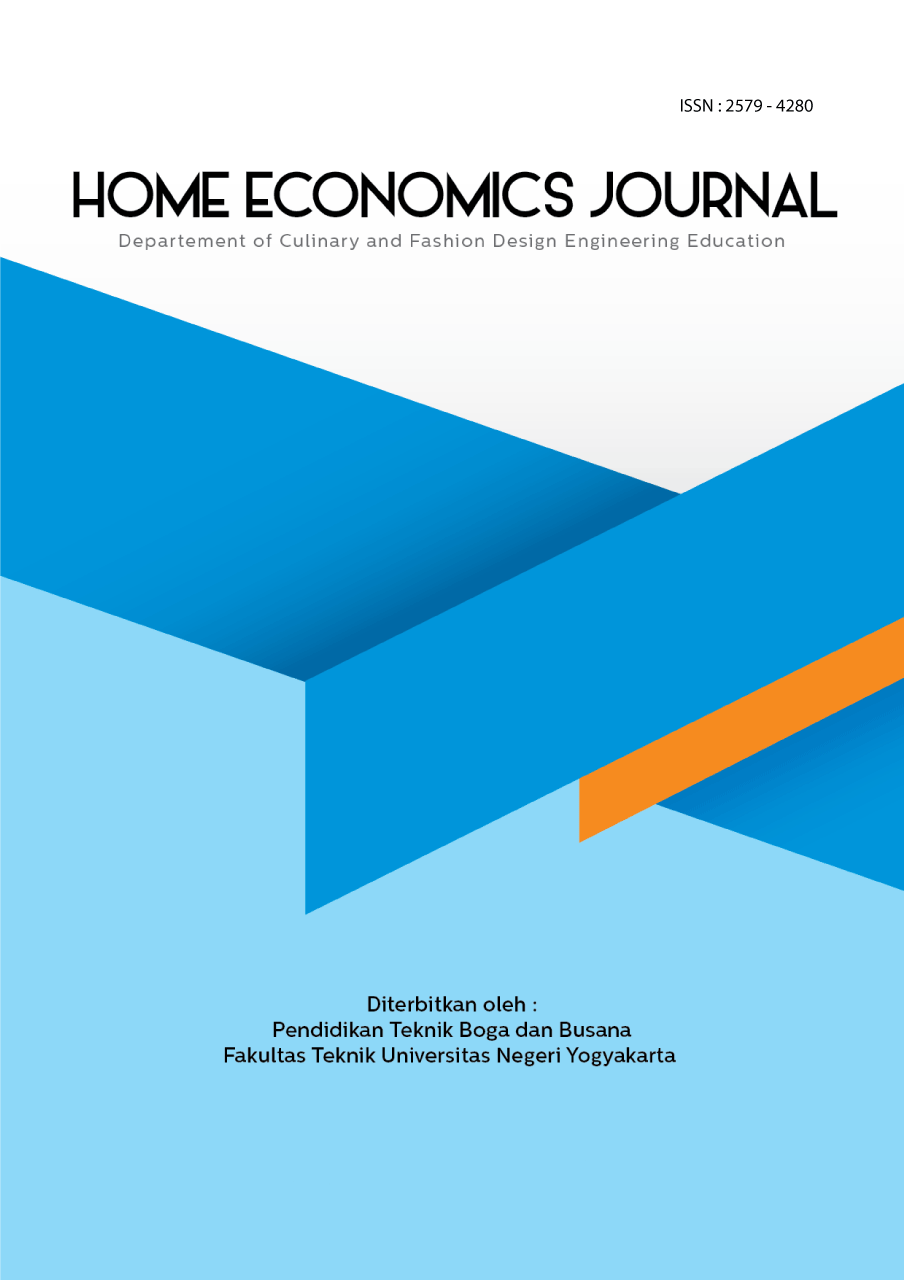ANALYSIS OF THE USE OF INTERFACING TYPES ON THE QUALITY OF VESTS
DOI:
https://doi.org/10.21831/hej.v8i2.73313Keywords:
Corak Insang Pontianak, Interfacing, Semi-Silk, Quality VestAbstract
This research aimed to determine the characteristics of cufner, mori gula, and tricot as interfacing on semi-silk material of Corak Insang Pontianak fabric, the quality of vest products used semi-silk material of Corak Insang Pontianak fabric with cufner, mori gula, and tricot. The type of research was descriptive exploratory with a survey approach. The subject of this research was a vest design using semi-silk materials of Corak Insang Pontianak fabric with three types of interfacing. The study was repeated three times tests. Data collection used observation sheets by expert and trained panelists. Aiken's V values were 0.94, and Cronbach's Alpha was 0.762, meaning the instrument was valid and reliable. Quality indicators were measured from surface flatness, adhesion strength, surface texture, material fall, and total look. The results of the quantitative data were analyzed using a descriptive test. The results showed that the characteristics of cufner as interfacing on semi-silk material of Corak Insang Pontianak fabric was more appropriate to be used on vest, because it could support product quality standards very well compared to mori gula and tricot; The quality of vest products used semi-silk material of Corak Insang Pontianak fabric with cufner got a percentage value of 88% with an excellent category, mori gula 70% with a suitable category, and tricot 78% with a good category. It could be concluded that interfacing gave the best results based on the indicators of product quality assessment of vests using semi-silk materials compared to tricot and mori gula.
References
M. Mealiah, "Modul Perkuliahan (Busana Tailoring)". Bandung: Universitas Pendidikan Indonesia, 2010, hlm. 2.
H. Jhosep & Armstrong. "Pattern Making for Fashion Design". Los Angeles: Pearson, 2010.
G. Poespo, "Tailoring Membuat Blazer dalam 1 Hari". Yogyakarta: Kanisius, 2009, hlm. 7.
V. Nemes, "Fabric Spreading and Cutting". Cambridge: Woodhead Publishing, 2009.
V. Nemes, "Fusing Cut Textile Components". Cambridge: Woodhead Publishing, 2012.
Nift. (2017). Interfacing and Fusing Techniques. [Online]. Available: http://id.scribd.com/presentation/341871671/s-interfacing-fusing, hlm. 40.
K. Hendrickson. (2009). Interfacings. [Online]. Available: http://4h.ucanr.edu/files/61587.pdf
N. P. N. Rahmawati. (2017). Corak Insang: Motif Tenun Tradisional Pontianak yang Tetap Bertahan. [Online]. Available: http://www.pustaka-bpnbkalbar.org
Direktorat Warisan dan Diplomasi Budaya. (2017). Warisan Budaya Takbenda Indonesia: Tenun Corak Insang Pontianak. [Online]. Available: https://warisanbudaya.kemdikbud.go.id/
D. D. Paluseri, (ed.), "Warisan Budaya Takbenda Indonesia Penetapan Tahun 2017". Jakarta: Direktorat Warisan dan Diplomasi Budaya, Ditjen Kebudayaan, Kementerian Pendidikan dan Kebudayaan, 2017, hlm. 179.
B. Kartika, "Pedoman Uji Inderawi Bahan Pangan". Yogyakarta: PAU Pangan dan Gizi Universitas Gajah Mada, 1988.
Sugiyono, "Metode Penelitian Pendidikan Pendekatan, Kuantitatif, Kualitatif, dan RnD". Bandung: Alfabeta, 2018.
R. Karlina, "Perbedaan Hasil Jadi Jas Wanita yang Menggunakan Interfacing Kufner dengan Interfacing Mori gula". Diploma thesis, Dept. Eng., Universitas Negeri Makassar, Makassar, 2019.
C. W. Keist, "Quality Control and Quality Assurance The Apparel Industry". Cambridge: Woodhead Publishing, 2015.
G. Thilagavathi, & S. Viju, "Process Control in Apparel Manufacturing". Cambridge: Wooddhead Publishing, 2013.
S. Liang, et. al. (2016). Design and Practicability Evaluation: A Novel Platform for Fabric Machine Ironing. International Journal of Clothing Science and Technology. 28(04), pp. 1-15.
G. Poespo, "Tailoring Membuat Blazer dalam 1 Hari". Yogyakarta: Kanisius, 2009, hlm 25.
K. Phebe, K. Krishnaraj, & B. Chandrasekaran. (2014). Evaluating Performance Characteristics of Different Fusible Interlinings. Indian Journal of Fibre and Textile Research. 39(1), pp. 380-385.
W. Zahri, "Modul Tailoring". Padang: Universitas Negeri Padang, 2007.
S. Wulandari, "Perbedaan Hasil Pembuatan Blazer antara yang Menggunakan Interfacing Kufner (Woven) dengan Interfacing Mori gula (Non Woven)". Skripsi, Dept. Eng., Universitas Negeri Semarang, Semarang, 2013.
V. C. Valentina. (2016). Pengaruh Jenis Interfacing terhadap Hasil Jadi Lengan Belimbing (Starfruit Sleeve) pada Busana Pesta Anak Menggunakan Bahan Taffeta. e-Journal. Vol. 05 No. 02, Edisi Yudisium Periode Mei 2016, pp. 40-48.
Singer, "Tailoring". U.S.A: Cataloging in Publication Data, 1998.
N. Fitrihana, "Memilih Bahan Busana". Klaten: PT Intan Sejati, 2011.
K. Kim, S. Sonehara, & M. Takatera. (2013). Quantitative Assessment of Jackets Appearances with Bonding Adhesive Interlinings Using Two-Dimensional and Three-Dimensional Analysis. International journal of affective engineering. 12(2), pp. 177-183.
N. Fitrihana, "Pengendalian Mutu Busana". Yogyakarta: KTSP, 2012, hlm 25.
Nift. (2017). Interfacing and Fusing Techniques. [Online]. Available: http://id.scribd.com/presentation/341871671/s-interfacing-fusing, hlm. 32.









